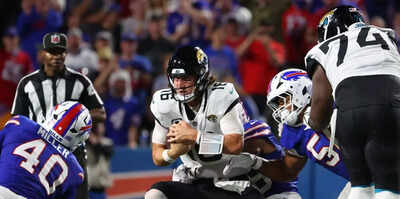- News
- Sports News
- NFL News
- NFL Workout Secrets: How the Pros Stay Fit and Injury-Free
Trending
NFL Workout Secrets: How the Pros Stay Fit and Injury-Free
The article explores the fitness demands for NFL players in various positions assessed through tests like the 40-yard dash and vertical jump. It underscores the role of balanced nutrition, cross-training, rest days, and injury prevention exercises in improving athletic performance and ensuring long-term well-being.

Image via Getty Images
Also Read: How NFL Coaches Prepare Their Teams: Inside the Strategy Room
The 40-yard dash
The 40-yard dash is a sprint covering 40 yards, used by scouts to evaluate American football players' speed and acceleration for the NFL draft and collegiate recruiting. A player's recorded time can significantly impact their prospects in college or professional football. Traditionally, it was only for "skill" positions like running back, wide receiver, and defensive back. However, a fast 40-yard dash time is now considered important for almost every position.
How Football Players Train To Make It In the NFL | What It Takes
Standing broad jump
The standing broad jump is an athletics event, one of three standing variants of track and field jumping, including the standing high jump and standing triple jump. It involves the jumper standing at a marked line with feet slightly apart, taking off and landing using both feet, swinging arms, and bending knees for forward drive. The jump must be repeated if the athlete falls back or takes a step.
Proper nutrition
A balanced diet is crucial for an athlete's fitness, incorporating whole foods like lean proteins, complex carbohydrates, healthy fats, and fruits and vegetables. Consistent water intake is also essential. Understanding the link between nutrition and performance helps young athletes make informed dietary choices.
Cross-Training and rest days
Cross-training involves participating in various sports and activities to enhance athleticism, prevent injuries, and develop a well-rounded set of physical abilities. Young kids should prioritize rest and recovery days to allow muscles to repair and grow. These practices contribute to players' long-term well-being by preventing burnout and promoting balanced physical development.
Injury prevention exercises
Injuries can be a major concern for young children, especially when playing sports. To prevent injuries, it's essential to incorporate injury prevention exercises into training routines. These exercises strengthen muscles, improve joint stability, and enhance flexibility. Focusing on areas prone to injuries like ankles, knees, and hips can reduce the risk of sprains, strains, and tears. Regular exercises like squats, lunges, balance drills, and plyometrics can also be beneficial.
Also Read: Top players who were undrafted in NFL history ft. Priest Holmes, Adam Oates and more
End of Article
FOLLOW US ON SOCIAL MEDIA










